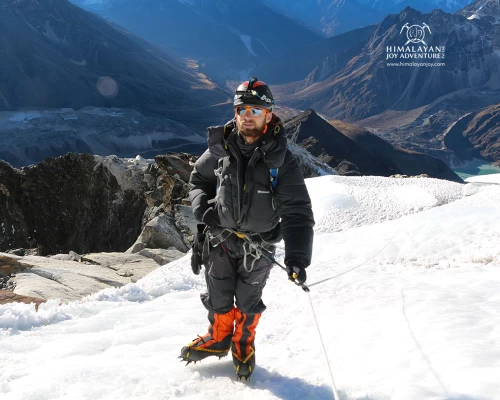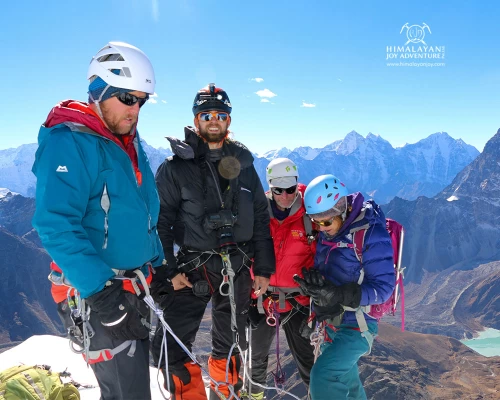Trek Highlights - Lobuche Peak Climbing
Summiting Lobuche East (6,119 m / 20,075 ft)
Scenic Flight to Lukla
Trekking through the Legendary Everest Trail
Acclimatisation at Namche & Dingboche
Breathtaking Panoramas from Lobuche High Camp
Close Encounter with Everest Base Camp Region (Optional Side Trip)
Experience Himalayan Mountaineering
Rich Sherpa Culture & Monasteries
Crossing Suspension Bridges & River Gorges
Adventure + Achievement
Lobuche Peak Climbing Overview!
Lobuche Peak is a popular trekking peak in the Everest region of Nepal. Lobuche has two main peaks: Lobuche East altitude 6,119 meters / 20,075 feet) and Lobuche West (6,145 meters / 20,161 feet). Among these, Lobuche East is more frequently climbed by trekkers and mountaineers. The carefully crafted trail for this peak climb offers tourists an authentic climbing experience along with breathtaking views of the surrounding Himalayas. One of the peaks' highlights is the opportunity to witness numerous other majestic peaks, including Mt. Everest, Mt. Lhotse, Mt. Nuptse, Mt. Makalu, Mt. Ama Dablam, Khangtenga, and Tawache.
Lobuche Peak features two distinct summit edges: the east edge (6119 m), recognised as a trekking peak, and the west edge (6145 m), known as an Expedition Peak. The mountain's allure lies in its various existing routes, making it appealing to both seasoned climbers and those new to peak climbing. Accessing Lobuje East involves descending a marked notch before ascending steep, snowy slopes to the summit. The successful ascent of Lobuche Peak was first achieved by Laurence Nielson and Ang Gyalzen Sherpa in 1984.
The trek to Lobuche Peak begins with a 35-minute flight from Kathmandu to Lukla, followed by a journey through Phakding and Namche Bazar. The route then leads to Everest Base Camp, Gorak Shep, Kala Pathar, and finally, the Lobuche Peak region. An alternative route involves following the Gokyo valley route, reaching Chola Pass, and then ascending to Lobuche Peak. After making an excursion to the summit, trekkers return via the same route to Lukla before heading back to Kathmandu.
Permit for Lobuche peak climbing
Climbing Lobuche Peak requires a permit issued by the Nepal Mountaineering Association (NMA). You need to obtain this permit through a registered trekking agency in Nepal. Spring (March–May) is approximately USD 250 per person. Autumn (September–November) is around USD 125 per person. similarly, Winter and Summer: About USD 70 per person.
How difficult is climbing to Lobuche Peak?
Climbing Lobuche Peak is moderately difficult. It requires good physical fitness and basic mountaineering skills, including using crampons, ice axes, and ropes. The altitude (over 6,100m) adds to the challenge, with risks of altitude sickness. It's suitable for trekkers with some climbing experience or those who’ve completed basic training.
How to prepare for climbing to Lobuche Peak?
Physical Fitness:
Train 3–6 months in advance.
Focus on cardio (running, hiking), strength (legs/core), and endurance.
Technical Skills:
Learn basic mountaineering: ice axe use, crampon walking, rope work.
Practice on smaller peaks or join a mountaineering course.
Acclimatization:
Follow a proper trekking itinerary (via Everest Base Camp) to adjust to altitude.
Gear Preparation:
Pack essential climbing gear: mountaineering boots, harness, crampons, ice axe, helmet, down jacket, layers, etc.
Mental Preparation:
Be ready for harsh weather, long days, and altitude challenges.
Permits & Logistics:
Arrange permits (Lobuche Peak climbing permit, Sagarmatha National Park).
Book a guide/agency if not going solo.
Health Precautions:
Bring a first aid kit, altitude meds (Diamox), and stay hydrated.
Get travel insurance that covers high-altitude climbing.
Base Camp and High Camp
The typical starting point for Lobuche East climbing is Lobuche Base Camp, situated at an altitude of around 4,900 meters. After Lobuche Base Camp, climbers typically establish a High Camp at around 5,600 to 5,800 meters, depending on the route chosen.
Climbing Route for Lobuche Peak
The ascent of Lobuche East involves a snow and ice climb, and the route may include some technical sections. The final summit push is usually made early in the morning to take advantage of stable weather conditions.
Best Time to Climb to Lobuche
The best time to climb Lobuche Peak is during the pre-monsoon (spring) season (April to May) and the post-monsoon (fall) season (September to November). During these times, the weather is relatively stable, and the visibility is better.
Guides and Support
It's advisable to hire a local guide and support staff, including a climbing guide with experience in the region. They can provide guidance on the route, ensure safety, and assist with logistics.
Equipments
Climbers need to bring appropriate mountaineering equipment, including crampons, ice axes, harnesses, helmets, and other technical gear. Proper clothing for extreme cold conditions is essential.
Before attempting Lobuche Peak, it's crucial to undergo thorough physical training, acquire the necessary gear, and be well-prepared for the challenges of high-altitude mountaineering. Always check for the latest information and guidelines, as conditions and regulations may change.





